
Campanula is one of several genera in the family Campanulaceae with the common name bellflower. It takes both its common and its scientific name from its bell-shaped flowers—campanula is Latin for "little bell".

The family Campanulaceae, of the order Asterales, contains nearly 2400 species in 84 genera of herbaceous plants, shrubs, and rarely small trees, often with milky sap. Among them are several familiar garden plants belonging to the genera Campanula (bellflower), Lobelia, and Platycodon (balloonflower). Campanula rapunculus (rampion) and Codonopsis lanceolata are eaten as vegetables. Lobelia inflata and L. tupa and others have been used as medicinal plants.

Campanula rotundifolia, the harebell, is a herbaceous perennial flowering plant in the bellflower family Campanulaceae. It has a circumpolar distribution in the Northern Hemisphere, from about latitude 40° N to about 78° N, extending in Europe from the north Mediterranean to the arctic.

Campanula americana, the American bellflower, is a tall bellflower native to eastern North America from the Great Lakes region south to Florida and from the Dakotas east to New York. This native plant is an annual or biennial from 2-6' tall. Its flowers are light blue to violet and are usually arranged in elongated clusters. It is an unusual bellflower in that its flowers are usually flat and not bell-shaped. It has a varying life-history with seeds germinating in the fall producing annual plants and spring-germinating seeds producing biennial plants. It is generally insect-pollinated, and does not usually self-pollinate.
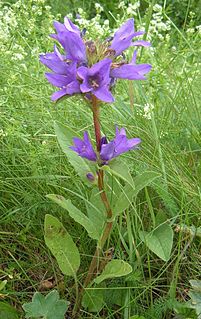
Campanula glomerata, known by the common names clustered bellflower or Dane's blood, is a species of flowering plant in the genus Campanula, belonging to the family Campanulaceae. It is the county flower of Rutland, England.
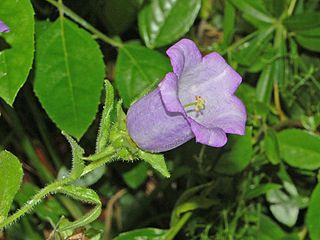
Campanula medium, common name Canterbury bells, also known as the bell flower, is an annual or biennial flowering plant of the genus Campanula, belonging to the family Campanulaceae. In floriography, it represents gratitude, or faith and constancy.

Campanula latifolia, the giant bellflower, is a species of bellflower in the family Campanulaceae. It is also known as the large campanula and the wide-leaved bellflower. It is native to Europe and western Asia and is widely grown as an ornamental plant.
1077 Campanula, provisional designation 1926 TK, is a presumed Erigonian asteroid from the inner regions of the asteroid belt, approximately 9 kilometers in diameter. It was discovered on 6 October 1926, by German astronomer Karl Reinmuth at the Heidelberg Observatory in southwest Germany. The asteroid was named after the bellflower Campanula.

Campanula trachelium, the nettle-leaved bellflower, is a species of bellflower. It is a Eurasian blue wildflower native to Denmark and England and now naturalized in southeast Ireland. It is also found southward through much of Europe into Africa.
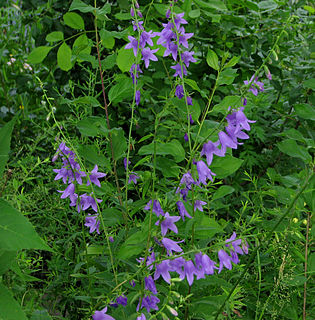
Campanula rapunculoides, known by the common names creeping bellflower, or rampion bellflower, is a perennial herbaceous plant of the genus Campanula, belonging to the family Campanulaceae.

The Circumboreal Region in phytogeography is a floristic region within the Holarctic Kingdom in Eurasia and North America, as delineated by such geobotanists as Josias Braun-Blanquet and Armen Takhtajan.

Campanula rapunculus, common name rampion bellflower, rampion, or rover bellflower, is a species of bellflower (Campanula) in the family Campanulaceae.

Campanula gelida is a stenoendemic, critically endangered species of perennial bellflower growing in the mountains of Hrubý Jeseník in the Czech Republic. It evolved through specialization of an isolated population of Campanula scheuchzeri, an Alpine species, which expanded to the area of the Sudetes during a colder period, probably the last ice age. It is closely related to Campanula bohemica, endemic to the Krkonoše Mountains.
Sometimes it is even considered its subspecies and referred to as Campanula bohemica subsp. gelida.
They all belong to the group of related species Campanula rotundifolia agg.
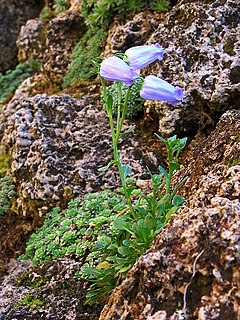
Campanula zoysii, known commonly as Zois' bellflower, Zoysi's harebell, or crimped bellflower, is a flower in the genus Campanula (bellflowers).

Eupithecia denotata, the campanula pug, is a moth of the family Geometridae. The species can be found from western Europe to central Asia and China.

Campanula cochleariifolia, common name earleaf bellflower or fairy's-thimble, is a species of flowering plant in the genus Campanula of the family Campanulaceae, native to the Pyrenees, Alps, and Carpathian Mountains of Central Europe. It is a rhizomatous herbaceous perennial growing to 10 cm (4 in). Clumps of bright green leaves produce nodding pale blue bell flowers on wiry stalks.
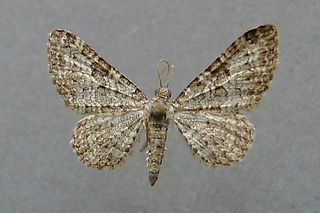
Eupithecia impurata is a moth of the family Geometridae. It is found from the mountainous areas of western, eastern and southern Europe up to Western Asia.
Light Brocade was a British Thoroughbred racehorse and broodmare. She was one of the best two-year-old fillies in England in 1933 when she won three of her four races including the Molecomb Stakes and Cheveley Park Stakes. In the following year she finished second in the 1000 Guineas before recording her biggest win in the Epsom Oaks. She was beaten in her only subsequent start and retired with a record of four wins from eight starts. She made little immediate success as a broodmare but her female-line descendants went on to have great success in Japan.
Campanula was a British Thoroughbred racehorse and broodmare. In 1933 she won two of her five races including the Windsor Castle Stakes and the Moulton Stakes and was rated the best juvenile filly in England. In the following spring she won the Column Produce Stakes and then recorded her biggest win in the 1000 Guineas. In her two subsequent races she finished fourth in the Epsom Oaks and second in the Champion Stakes. As a broodmare she exerted an enduring influence as a broodmare through her daughter Calluna.















